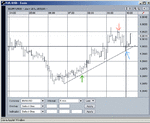GammaJammer said:
JO - I've just read your post and it puzzled me a bit. Surely if you're long in one account and short in another the positions net off and all you're doing is tying up trading capital.
Are you really saying that you want to find a way of splitting up the short term and long term P+L for analysis purposes? as this seems to me to be the only benefit you'd gain from what you are describing.
I often trade a shorter time frame while I'm in a longer position. Usually it's an attempt to improve the average rate at which I'm in my longer term position. Ideally every trade ends up with the same stop loss you put on when you opened the trade, but with a guaranteed profit even at that level. Then you can have a bit more leeway in leaving the position on. This is often known, at least in FX, as jobbing (a term which I think may mean something else in equities - FB?).
I may for example buy a breakout, cut half position at some predetermined point (often equivalent to some multiple of distance from entry to stop level) but then may lookm to re-establish full sized long on a retracement. Do that a couple of times and you've locked in a guaranteed profit even at your original stop level (I know this isn't rocket science). If however I was really sure the market had hit a temporary brick wall I could of course sell the whole position, and re-establich at a lower level. But in such a circumstance I wouldn't be overly concerned about HOW to reflect the P+L. All ends up in the same pot at the end of the day. Sometimes that pot belongs to me, sometimes to the bookies.
GJ
Some platforms (
www.cms-forex.com for instance) allow you to hedge an open position with a trade in the opposite direction. Here why a trader might want to do it:
In the chart below, I was long at the green arrow. Although I wanted to stay in my long position, I saw a setup for a retracement at the orange arrow which might be as large as 30% of the current profit in the position. There are at least three or 4 options here.
Gut out the retracement, and wait to see if the uptrend continues.
Exit the position and wait to enter long again at when you see the setup you want.
Exit the long position and go short.
Hedge the long position with a short entry at the orange arrow
(close the hedge at or slightly after the blue arrow, and continue with your long pos...)
Call me greedy., but I when I work the math, the 4th option makes a fatter bank account (assuming you can pick the entries). Now that's a big assumption for me, but I know that experienced traders do it.
The beauty of the hedge, is that if the price crashes through support, you close the long instead, and your short entry has a perfect reason for a tight stop.
I'd also like to be able to hedge if I'm in a position with significant profit, and I expect the trend to continue, but I need to go eat lunch or run an errand. I'll probably lose some profit while I'm away, but I can leave without fretting, and when I get back, if I like what I see, I 'm still in the original position, - and I don't have to wait (possibly hours) for a good re-entry setup.
Your mileage may vary...
JO







